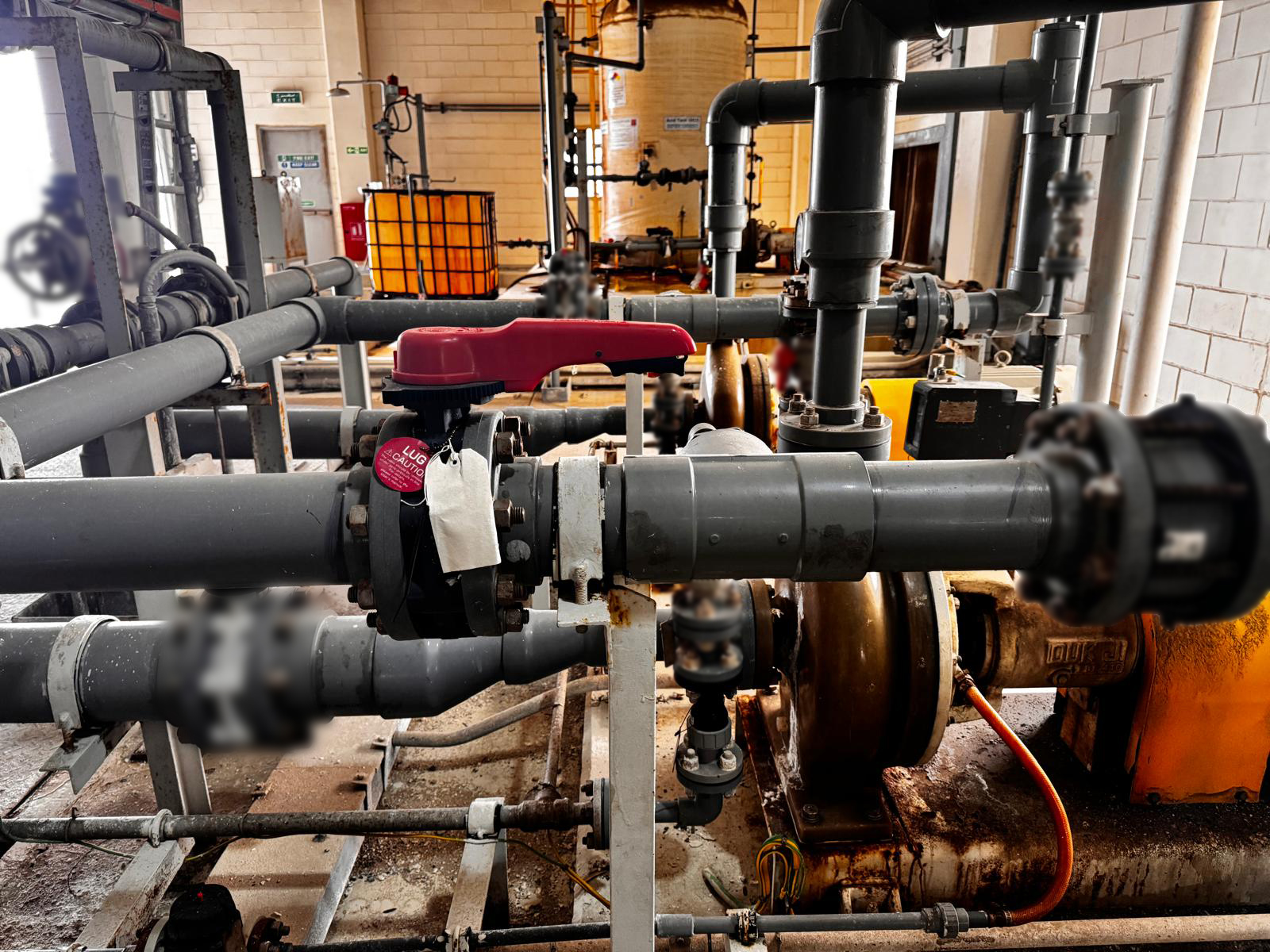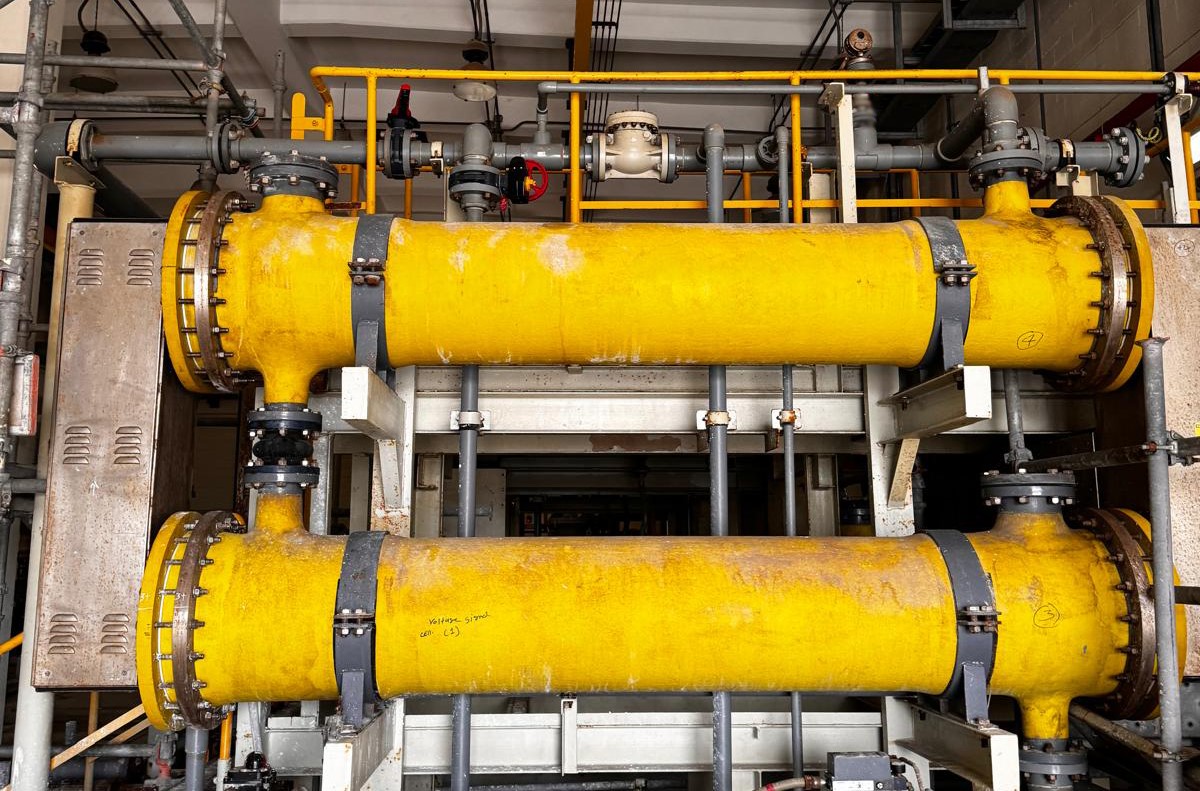Kuwait is located on the Arabian Peninsula with the Persian Gulf to its east and has a population of approximately 4.3 million.
With most of the country having a desert climate, Independent Water and Power Plants (IWPP), which combine desalination facilities
with power generation facilities, support its citizens’ daily lives.
The Az-Zour North power and water plant (hereafter referred to as AZN IWPP) is one of Kuwait's top three power plants in terms of
generation capacity and desalination capacity.
We meet with Sagar Damani, the CFO of the AZN Operation and Maintenance Company (hereafter referred to as AZN O&M), which maintains
the plant, and maintenance manager Atikur Rahman to discuss the significance of their work and their use of ASAHI AV valves.
ASAHI AV valves have been used at AZN IWPP since the start of its commercial operations in 2016.
(Left to right: Mr. Damani, Mr. Rahman)
What is the function of the AZN IWPP?
The AZN IWPP is located about a hundred kilometers south of Kuwait City, the country's capital, with the Kuwait-Saudi Arabia border to the south
and the Persian Gulf to the east. It combines a gas-fired power plant with a desalination plant, accounting for approximately twelve percent of
Kuwait's electricity and approximately twenty-five percent (approx.450,000㎥/day) of its drinking water.
The desalinated drinking water and generated power are supplied to the Kuwait Ministry of Electricity and Water under a 40-year long-term Energy
Conversion and Water Purchase Agreement, contributing to the country’s growth and prosperity.
The plant uses multi-effect distillation (MED) to turn seawater into drinking water. With this technology, seawater is passed through multiple
tubes and progressively placed under pressure and vaporized using surplus heat from the neighboring power plant. AZN O&M, which maintains and
manages AZN IWPP, is a fifty-fifty joint venture company between French water treatment company ENGIE and Sumitomo Corporation, both also
investors in the plant.
An Unstoppable Responsibility
Damani: This is our eighth year managing the AZN IWPP. We live in Kuwait, which is mostly desert and has, without exaggeration, almost zero water resources.
Desalination plants like ours produce a stable supply of potable water from seawater and are said to account for about 98 percent of Kuwait's drinking water.
As such, the drinking water produced at the plant we manage is an indispensable lifeline for Kuwait's citizens.
We’re one of Kuwait’s top three power plants in terms of power generation and drinking water production. The country and its citizens rely heavily on us,
so we go about our work with a strong sense of responsibility. Our plant began commercial operations in 2016, and since then, operations have continued
uninterrupted 24 hours a day, 365 days a year.
We see ourselves as not just providing a lifeline but also supporting Kuwait’s economic development. ASAHI AV valves, which are high quality and function
stably, are indispensable in the plant’s operation.

The immense responsibility of managing a lifeline facility
Damani: The power generation and desalination facilities use several thousand metal and resin valves. Each valve is chosen to match a specific temperature,
air pressure, flow rate, etc., and engineers regularly maintain them according to strict management standards to prevent significant accidents. The annual
inspection of the units is one example. Each unit undergoes a planned shutdown for a visual inspection and specific plant maintenance. Electricity and drinking
water are lifelines, so we cannot stop production. So we have to have a detailed plan in place.
Compared to other plants in the region, which are about twenty to twenty-five years old, our facility is only about eight years old and is relatively new.
While we can identify the location of even minor errors by monitoring the facilities, the responsibility of managing a lifeline facility is immense, so we hope
to stay open to good solutions.
ASAHI AV valves are used extensively in the electrolyzer of the seawater desalination plant, which is particularly vulnerable to corrosion. However, we started
commercial operations in 2016, and as far as I can remember, we’ve never had an issue with an ASAHI AV valve.
The electrolysis line operates around the clock and is crucial for providing residents with a stable supply of drinking water. We inspect the valves as per
the maintenance guidelines. And while we’ve changed things like the gland packing, surrounding bits, gaskets, and bolts, I don’t remember ever changing the
valve itself. I’m confident that the ASAHI AV valves, which have been problem-free since 2016, will help us maintain quality as we carry out our forty-year,
long-term Energy Conversion and Water Purchase Agreement.
Provides peace of mind
Rahman: Maintenance involves more than just the cost of the valve or the product itself. There’s also the labor and time that goes into exchanging it. The more
spots you need to replace, the higher the cost becomes. So, on the maintenance and management side, we have to look at the whole picture and see what would be the
most economical. In that regard, being able to hold extensive discussions with Asahi Yukizai (parts supplier) and Sumitomo Corporation (investor) has helped us
build a strong business relationship. And it’s one that we hope will continue. Our plant has an operation rate of ninety-seven to ninety-eight percent. To maintain
this, we want to stay in close communication with Asahi Yukizai. IWPPs like ours are one of the most efficient ways to co-generate power and water and, as such, are gaining greater importance. The use of IWPPs by GCC countries
has increased in the last twenty years. While many are shifting their focus to renewable energy, Kuwait is focusing on IWPPs. We appreciate that ASAHI AV valves are
low maintenance. They provide us in management with peace of mind.

Used in the seawater intake line of the desalination plant.
The importance of new solutions
Rahman: We currently use large-size, metallic, motorized butterfly valves for the line that intakes seawater. While we regularly maintain them, there have been a few
incidents of flow malfunctions. Since resin valves don’t rust, I think we could consider installing more ASAHI AV valves if the size and functionality specifications match.
And while it may be difficult, I think we can also consider replacing the metal valves with resin valves if they’re reliable, require less maintenance, and, as a result,
reduce costs. These are important points for us and will aid us in providing a stable supply of electricity and drinking water.